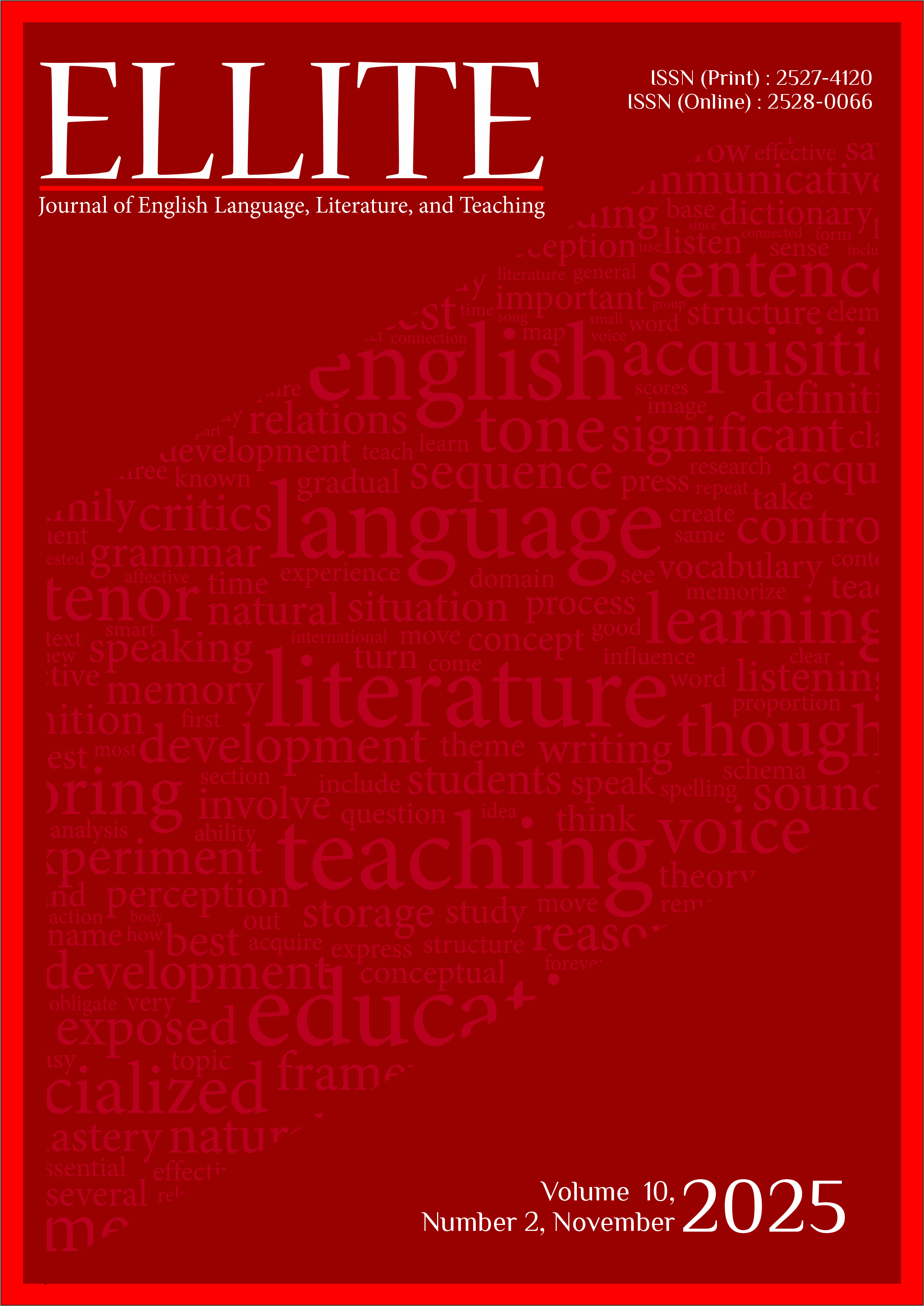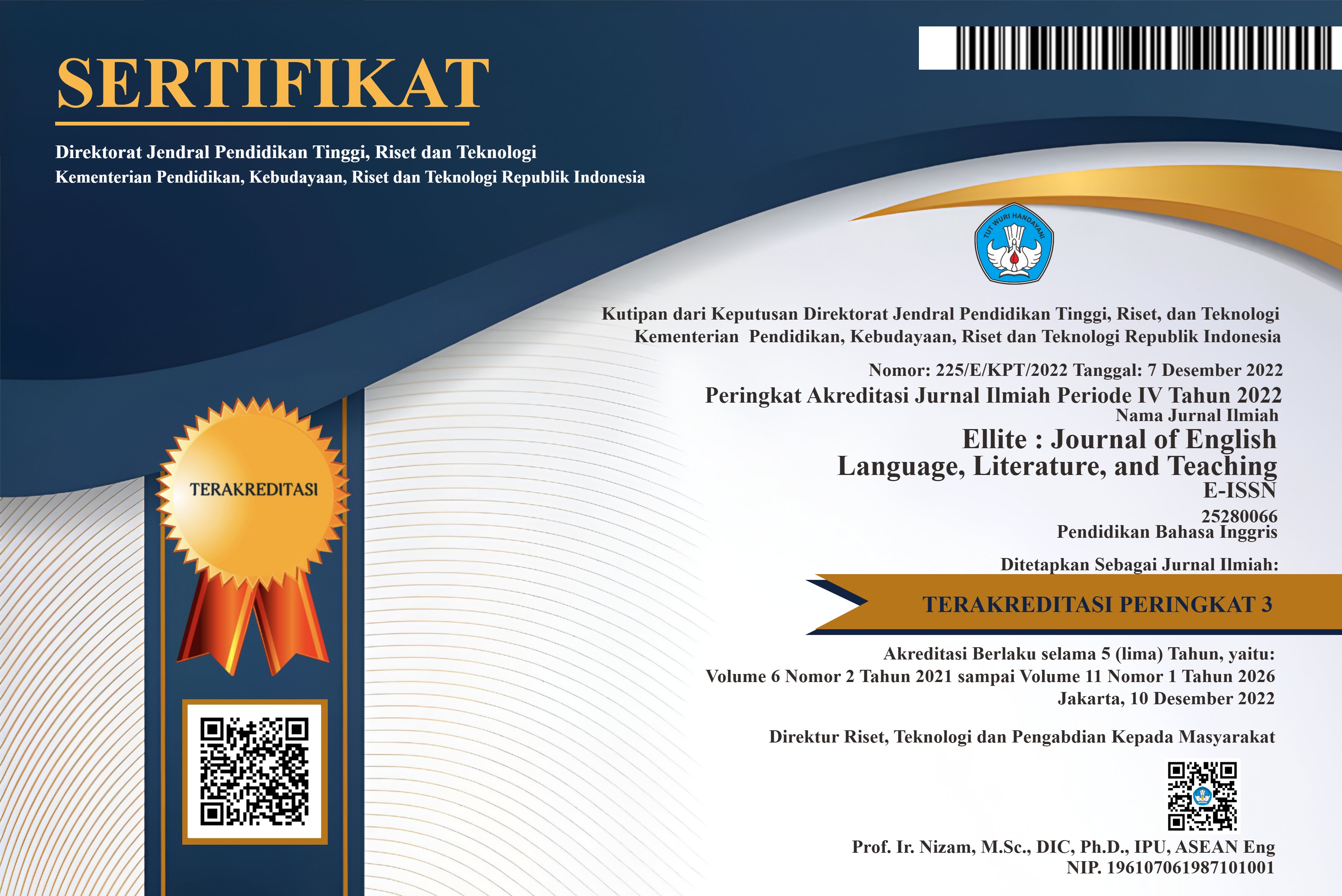Big Five Personality Traits and Metaphor Construction: A Correlational Study on English Literature Students
DOI:
https://doi.org/10.32528/ellite.v10i2.3876Keywords:
Creativity, Big Five Personality, Linguistics, MetaphorAbstract
Metaphor is one of the essential elements of language that reflects a person’s level of creativity and capacity for abstract thinking. This study aims to identify the relationship between students’ personalities—based on the Big Five Personality model—and their ability to construct metaphors in English, using the theoretical framework of Lakoff & Johnson (1980). Employing a quantitative correlational approach, the research involved 65 active students from the English Literature Program at Universitas Negeri Makassar, selected through stratified random sampling. The instruments used were the Indonesian-adapted version of the Big Five Personality questionnaire (IPIP) and a metaphor writing test consisting of 20 items. Pearson correlation analysis revealed that the dimension Openness to Experience had a strong and significant positive relationship with metaphor construction ability, establishing it as the strongest predictor. Conscientiousness also showed a significant positive correlation, while Neuroticism had a significant negative correlation. In contrast, Extraversion and Agreeableness were not significantly associated with metaphor ability. These findings highlight that certain personality aspects—particularly openness to experience and self-discipline—play an important role in supporting students’ linguistic creativity, especially in metaphorical expression.
References
Abu Raya, M., Ogunyemi, A. O., Rojas Carstensen, V., Broder, J., Illanes-Manrique, M., & Rankin, K. P. (2023). The reciprocal relationship between openness and creativity: from neurobiology to multicultural environments. Frontiers in Neurology, 14, 1235348.
Anglim, J., Horwood, S., Smillie, L. D., Marrero, R. J., & Wood, J. K. (2020). Predicting psychological and subjective well-being from personality: A meta-analysis. Psychological Bulletin, 146(4), 279.
Arun Kumar, P., & Lavanya, V. (2024). Igniting work innovation: performance pressure, extraversion, feedback seeking and innovative behavior. Management Decision, 62(5), 1598–1617.
Furnham, A., Hughes, D. J., & Marshall, E. (2013). Creativity, OCD, narcissism and the Big Five. Thinking Skills and Creativity, 10, 91–98.
Gavrilescu, M., & Vizireanu, N. (2018). Predicting the Big Five personality traits from handwriting. EURASIP Journal on Image and Video Processing, 2018, 1–17.
John, O. P. (1999). The Big-Five trait taxonomy: History, measurement, and theoretical perspectives. Handbook of Personality: Theory and Research/Guilford.
Kaufman, S. B., Quilty, L. C., Grazioplene, R. G., Hirsh, J. B., Gray, J. R., Peterson, J. B., & DeYoung, C. G. (2016). Openness to experience and intellect differentially predict creative achievement in the arts and sciences. Journal of Personality, 84(2), 248–258.
Kučera, D., Haviger, J., & Havigerová, J. M. (2022). Personality and word use: Study on Czech language and the big five. Journal of Psycholinguistic Research, 51(5), 1165–1196.
Lakoff, G., & Johnson, M. (1980). The metaphorical structure of the human conceptual system. Cognitive Science, 4(2), 195–208.
McCrae, R. R. (1987). Creativity, divergent thinking, and openness to experience. Journal of Personality and Social Psychology, 52(6), 1258.
Musolff, A. (2016). Cross-cultural variation in deliberate metaphor interpretation. Metaphor and the Social World, 6(2), 205–224.
Nacey, S. (2016). Metaphor comprehension and production in a second language. In The Routledge handbook of metaphor and language (pp. 521–534). Routledge.
Popova, T. G., & Kurochkina, Y. V. (2015). Metaphor as a mental and language mechanism. Язык, Литература и Культура Как Грани Межкультурного Общения, 223–227.
Rahman, A. U., & Halim, Z. (2022). Predicting the big five personality traits from hand-written text features through semi-supervised learning. Multimedia Tools and Applications, 81(23), 33671–33687.
Saucier, G., & Goldberg, L. R. (1998). What is beyond the Big Five? Journal of Personality, 66, 495–524.
Schäffner, C. (2004). Metaphor and translation: some implications of a cognitive approach. Journal of Pragmatics, 36(7), 1253–1269.
Silvia, P. J., Nusbaum, E. C., Berg, C., Martin, C., & O’Connor, A. (2009). Openness to experience, plasticity, and creativity: Exploring lower-order, high-order, and interactive effects. Journal of Research in Personality, 43(6), 1087–1090.
Yao, X., & Li, R. (2021). Big five personality traits as predictors of employee creativity in probation and formal employment periods. Personality and Individual Differences, 182, 109914.
Downloads
Published
Issue
Section
Categories
License
Copyright (c) 2025 Abd Halim, Mardiyanah Nasta, Nur Mutmainnna Halim

This work is licensed under a Creative Commons Attribution 4.0 International License.







